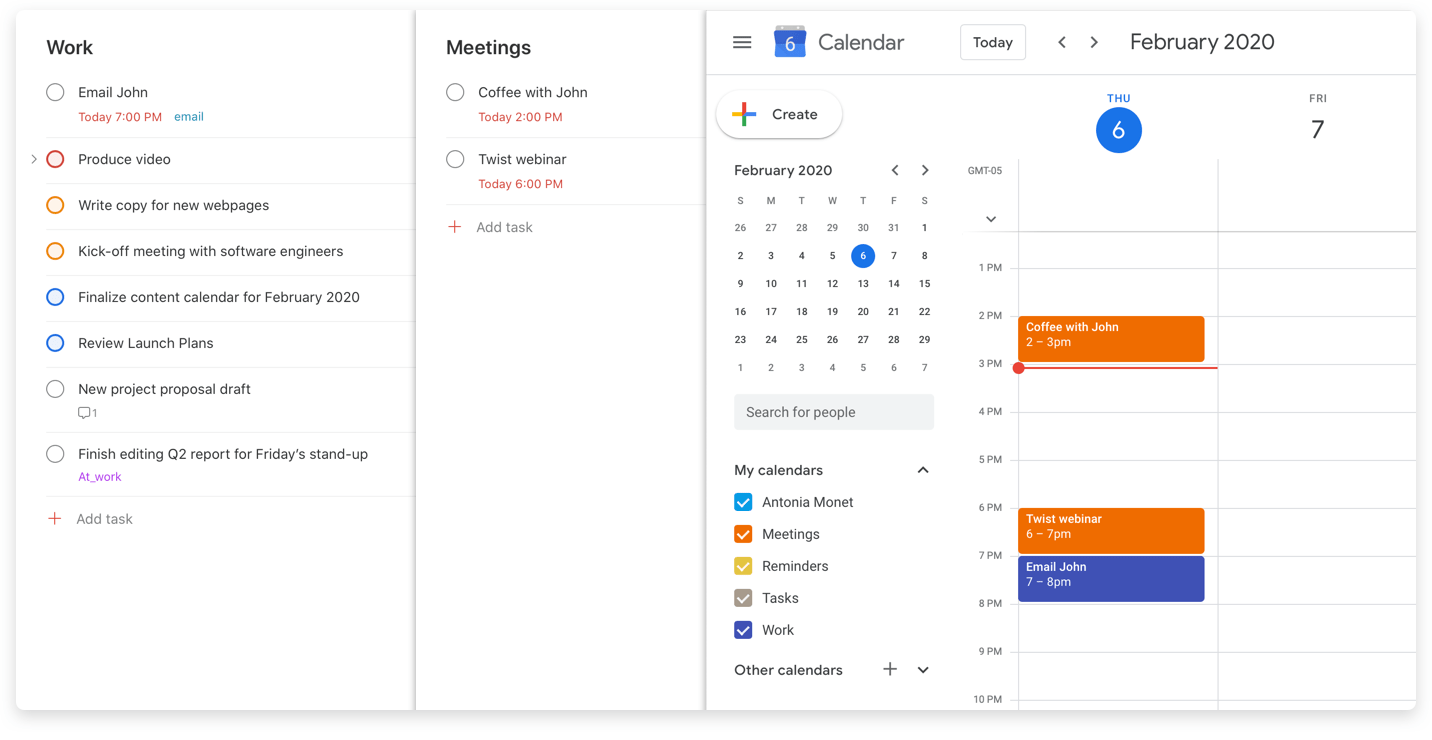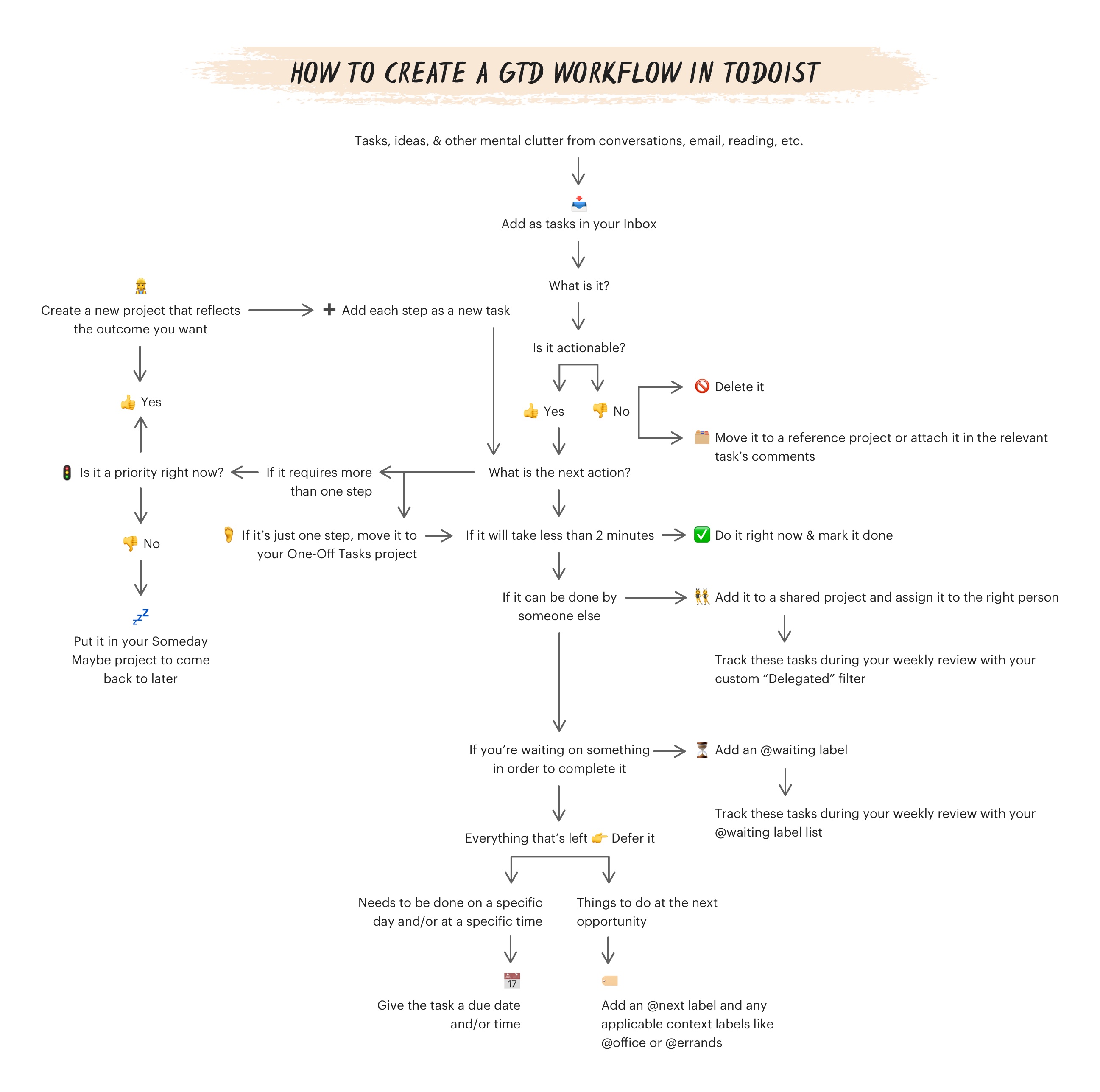Use Todoist for work, Habitica for personal. Perhaps another way to divide tasks between Todoist and Habitica is to split up work and personal projects. It is not the system I use, since there is overlap. For example, I’m reading a book that is helpful for my job, and interesting to me personally. I use todoist to capture my work tasks and my personal tasks. In the morning, I spend some time organising both types of tasks, and then I want to work on my work tasks. So I created the filter “today & #work” for this. And the tasks filter beautifully. But my problem is this.
- Todoist Separate Work And Personal
- Todoist Separate Work And Personal Property
- Todoist Separate Work And Personal Life
- Todoist Separate Work And Personal Benefits
- Todoist Separate Work And Personality
I use todoist to capture my work tasks and my personal tasks. In the morning, I spend some time organising both types of tasks, and then I want to work on my work tasks. So I created the filter “today & #work” for this. And the tasks filter beautifully. But my problem is this. Todoist allows you to add labels to tasks for another sorting option. This how I separate waiting tasks, although it’s not the perfect solution. I briefly created a separate project for pending tasks, but it didn’t work out as I liked, because it made it necessary to label each tasks with the original project name. Join 25 million people and teams that organize, plan, and collaborate on tasks and projects with Todoist. 'The best to-do list' by The Verge.
A work profile is set up on an Android device to separate work apps and data from personal apps and data. The work profile lives on a separate part of the device so that your personal things stay private and unaffected by work. In this article, you'll learn how to:
- Find your work profile.
- Tell the difference between work apps and personal apps.
- Get more apps for work.
- Pause your work profile.
Your IT support person can only manage the work-related email, apps, settings, and data on your device. They can’t access the personal email, apps, settings, and data. They also can’t reset or wipe your device.
To learn how to set up a work profile, see Create a work profile and enroll your device.
Identify work apps
Work apps are marked with a briefcase badge, while personal apps do not have a briefcase badge. Some screen readers and voice assistants identify work apps by saying 'work' before the app name.
| Personal app (no briefcase) | Work app (briefcase) |
|---|
After you've set up the work profile, you may see duplicate apps on your device. For example, you could have two Outlook apps. Use the version that's marked with the briefcase for work-related tasks.
Tip
For the best experience, always sign in to work apps with your work account, and sign in to personal apps with your personal account.
The appearance of the briefcase can vary slightly from device to device. To see how it appears on other Android devices, see the examples at the bottom of this article.
Find your work profile
Once you've set up a work profile, your organization can automatically install work apps on your device.
The location of the work profile varies by device manufacturer and Android version. This section describes where to find the work profile in the app drawer and on the home screen.
Note
If you're using a custom launcher, work apps can appear in places other than the app drawer or home screen folder.
App drawer
Swipe up on the home screen or select Apps to access the app drawer. Work apps appear alongside your personal apps or within a Work tab in your app drawer.
To see how it appears on other Android devices, see the examples at the bottom of this article.
Folder
On some devices, work apps are in a work-designated folder on the home screen. This folder is automatically created during setup.
To see how it appears on other Android devices, see the examples at the bottom of this article.
Get more work apps
Open the work version of the Google Play Store to see all of the apps your organization has made available to you.
Continue to use the work version of the Play Store to search for and install other apps for work. If you don’t see an app you need for work, you can request it from your IT support person.
The appearance of the Play Store app varies by device manufacturer and Android version, but the work version is always marked with a briefcase.
Pause the work profile
Pause the work profile to take a break from work apps and notifications. Pausing effectively turns off the work profile by disabling work apps and work notifications.
The location of the pause setting varies by device manufacturer and Android version (Android 7 and later is required). It's commonly found in quick settings, the Settings app, or the app drawer.
Quick settings pause option
Swipe down on your screen to access the quick settings menu. Tap Work profile to pause the work profile.
To see how quick settings appear on other Android devices, see the examples at the bottom of this article.
Settings app pause option

Open the Settings app and go to Work profile settings. Switch the Work profile toggle off.
To see how work profile settings appear on other Android devices, see the examples at the bottom of this article.
App drawer pause option
Swipe up on the home screen or select Apps to access the app drawer. Tap the Work tab and then switch the Work profile toggle off.
Examples
This section shows examples of how the work profile and its features appear on common Android devices. Those devices are:
- Surface Duo (Android 10)
- Google Pixel 4 (Android 11)
- Samsung Galaxy S20 (Android 10)
- Nexus 5X (Android 8.1.0)
Some features are not available on all devices.
Briefcase badge
These tables show examples of the briefcase badge that's used on work apps. For more information, see Identify your work apps.
| Surface Duo (Android 10) | Google Pixel 4 (Android 11) |
|---|
Todoist Separate Work And Personal
| Samsung Galaxy S20 (Android 10) | Nexus 5X (Android 8.1.0) |
|---|
Work profile in app drawer
These images show where the work profile appears in the app drawer. For more information, see Find your work profile.
Surface Duo (Android 10)
Google Pixel 4 (Android 11)
Samsung Galaxy S20 (Android 10)
Nexus 5X (Android 8.1.0)
Work profile folder
Todoist Separate Work And Personal Property
The following table shows examples of the work profile folder. For more information, see Find your work profile.
| Surface Duo (Android 10) | Samsung Galaxy S20 (Android 10) | Nexus 5X (Android 8.1.0) |
|---|
Pause in quick settings
These images show where the pause option appears in the quick settings menu. For more information, see Pause the work profile.
Surface Duo (Android 10)
Google Pixel 4 (Android 11)
Samsung Galaxy S20 (Android 10)
Nexus 5X (Android 8.1.0)
Pause in Settings app
These images show where the pause option appears in the Settings app. For more information, see Pause the work profile.
Surface Duo (Android 10)
Google Pixel 4 (Android 11)
Samsung Galaxy S20 (Android 10)
Nexus 5X (Android 8.1.0)
Pause in app drawer
These images show where the pause option appears in the app drawer on a Google Pixel 4 (Android 11). For more information, see Pause the work profile.
Next steps
Need more help figuring out the work profile? Contact your IT support person. For contact information, check the Company Portal website.
Having a good digital tool to help you organize your Getting Things Done system is essential. In this post, I’m showing you my Todoist GTD setup.
This is part one of a two-part series describing my Todoist GTD setup. You may find the next part here: My Todoist GTD setup – Part 2: Weekly Review and Focus Horizons.
I know that it is possible to do GTD on paper, but in my mind, having a good digital tool to help you organize your Getting Things Done system is essential. With today’s fast pacing and constantly changing priorities, I seriously do not see how people can manage this on paper. I find that 70% of my action items come from, or at least involves email. Going for a paper-based system would be a nightmare.
Getting Things Done (GTD) – What is it?

Read More
My GTD tool: Todoist
I think it is safe to say that I have tried most of the GTD tools on the market (as of summer 2016) I have ended up with Todoist Pro. This tool is not perfect, but with some tweaking, it works really well. My final reasons for choosing Todoist was the following:
- Flexibility: Todoist runs on every major platform. Windows, Windows 10 Mobile, Android, Android Wear, OS X, iOS, and web.
- Integration: Outlook Gmail, Chrome, Firefox, IFTTT, to name a few. See full list here: https://support.todoist.com/hc/en-us/articles/205143181-Integrations
- Todoist Karma. (It really works!)
- Trust: With more than 5 million users and a good customer service, I feel that this is a service I can literally build my life around.
Want to sign up for Todoist Premium?
In that case, I would appreciate if you use the below link. If you do that, I get two months Todoist Premium added to my account – with no extra cost for you. Thanks!
Sign up for Todoist Premium here
My Todoist GTD setup
Todoist Separate Work And Personal Life
Part of Todoist’s success is due to its flexibility. The downside of this flexibility is that you have to figure out how to set up Todoist as a GTD tool. I don’t think that my Todoist GTD setup is the one and only way to do this. It all boils down to how you have implemented GTD in your life. What I do know is that I’m in some way or another using most aspects of the Getting Things Done method, so I think that there will be something to learn for most GTD practitioners by reading this Todoist GTD setup guide.
[bctt tweet=”Remember this about GTD: The app comes second, the approach comes first.”]
Projects
According to Davin Allen, a project is anything that takes more than one step to complete. For all practical purposes, a project can be as defined by David Allen or used as a parking place for action items related to the same issue, project or type of work. Personally, I tend to use both types of projects.
In part two of this post, I will show how to use Todoist projects for managing Weekly Review and Focus Horizons.

Contexts (Labels)
(Please be aware that in order to use Labels, you must have a Todoist premium account.)
Contexts are maybe one of the most useful features in Getting Things Done. Used correctly they can multiply your productivity and turbocharge the way you work.
I define contexts as something both physical and mental. It can be the physical place you need to be. Some types of work can only be done at the office or at home. Some things can only be decided at the next department meeting or the next time you have sit-down time with your boss or customer. Because contexts have to be tailored to both the way you function as a person and the nature of your work, this is maybe the area where you will have to adjust your Todoist GTD setup the most.

It can also be useful to define important tools like computer or internet as a context. In periods when I travel a lot, I will have flight or offline as a context. This enables me to sort out the type of work I can do when flying with no access to WIFI.
A context can also be a mental state or role. I use a context called Work for everything work-related, independently of where I decide to work.
My contexts
Be aware that since Todoist does not have Next Action or energy levels defined as separate items in the software, you will have use Labels for this.
- Work
Anything work related that does not involve having to meet with other people. This is both a mindset context and a physical context. - Private
Anything private that can be done anywhere. - Home
Anything that I need to be physically at home to get done. - Cabin
Anything that I need to be physically at the cabin to get done. - Next Action
Just that. All of my next actions viewed in one place. - Phone
This context can be very handy in between two meetings or when driving a car. - Work.Ag.Mngr
Anything I need to discuss with my manager when we have time together. - Work.Ag.Team
Anything I need to discuss or inform about the next time we are all in the same room. - Follow-up
Any emails or delegated actions that are critical enough to warrant my time ensuring that it has been answered or done. - Low Energy
Things that I can do Friday afternoon or on a lazy Sunday morning.
Filters
Todoist Separate Work And Personal Benefits
This is probably the feature that I use the least.
- Next Action Work
All of my next actions for work-related projects.
This is what I choose from when I have done everything work-related on my Today list. - Work projects
All of my work-related projects in one place. - Home
The two contexts Home and Personal. - Cabin
The two contexts Cabin and Personal. - Next Actions @Home
This is what I choose from if I’m at home and have done all the private stuff on my Today list. - Next Actions @Cabin
This is what I choose from if I’m at the cabin and have done all the private stuff on my Today list. - Overdue
I better not find anything here. - Priority 1
What is most important in my life right now. - No due date and No context
I use these to do a “quality check” in my Weekly Review. - Next 30 days
What is in the way for my vacation or when doing long-term planning. - Compleated today
-No longer supported.
The ultimate guide to Todoist filters
Read More
Capturing tools
As a part of my Todoist GTD setup, I use the following tools and methods to capture information into Todoist.
Automated:
- Using IFTTT, I get action items for unanswered calls and SMS messages on my cell phone directly into my Todoist inbox.
- Using IFTTT and the local weather forecast, I get an action with priority 1 in the morning if it will rain or snow during the day.
On the move:
- Todoist shortcut on my Samsung Galaxy Note8
- Newton email integrates email with Todoist on my phone and tablet
- Braintoss captures pictures, notes and audiosnippet and sends in direcly to my Todoist inbox.
- Livescribe 3 smart-pen + App. Send notes to Todoist
- Mont Blanc ballpoint pen and a small Moleskine notebook
Todoist Separate Work And Personality
In the office and at home:
- Todoist Outlook add-in
- Square bank paper notes
Do not miss my next blog post: My Todoist GTD setup – Part 2: Weekly Review and Focus Horizons.
Related
